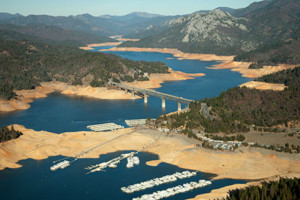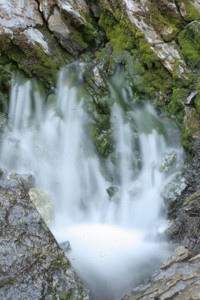
Summer 2017 ForestLife
Restoring Watersheds Key to California’s Future Water Supply
Pacific Forest Trust to Release First-ever Watershed Infrastructure Risk Assessment
 California weather is becoming characterized by more extreme variability with climate change. After two droughts in ten years followed by record rainfall that filled dams and cracked a hole in the Oroville dam’s spillway, water managers are struggling to fix dams to handle floods, while at the same time, preparing irrigation and other systems for the next drought.
California weather is becoming characterized by more extreme variability with climate change. After two droughts in ten years followed by record rainfall that filled dams and cracked a hole in the Oroville dam’s spillway, water managers are struggling to fix dams to handle floods, while at the same time, preparing irrigation and other systems for the next drought.
A new report by the Pacific Forest Trust looks further upstream to find a long-term and highly cost-effective solution: repairing and maintaining California’s watersheds.
The report, A Risk Assessment of California’s Key Source Watershed Infrastructure, to be released in August 2017, provides the first comprehensive assessment of the seven million acres across five watersheds that feed the Shasta and Oroville reservoirs. These are the core of the state’s utilized water supply. The report outlines a framework to restore and maintain them as resilient watersheds. Because these source watersheds will remain cooler and wetter than the rest of the state as climate change continues to advance, their healthy function grows even more critical to the state’s water security over time.
 Watersheds are areas defined by high ridges of land that determine the direction water flows, and naturally, California’s key watersheds are found in its mountainous northern regions that are the sources for five major rivers: the Upper Trinity, Upper Sacramento, McCloud, Pit, and Feather rivers. These five areas feed the reservoirs that provide water for more than 28 million people and the large majority of prime agricultural land in California.
Watersheds are areas defined by high ridges of land that determine the direction water flows, and naturally, California’s key watersheds are found in its mountainous northern regions that are the sources for five major rivers: the Upper Trinity, Upper Sacramento, McCloud, Pit, and Feather rivers. These five areas feed the reservoirs that provide water for more than 28 million people and the large majority of prime agricultural land in California.
Degradation of the forests, meadows, and streams in these source watersheds has led to reduced natural water capture and storage, altered water flow regimes, and more intense flooding. This assessment analyzes the scale and type of restoration needed to repair and maintain these key watersheds in order to improve the long-term security of California’s water supply.
The Pacific Forest Trust’s report, A Risk Assessment of California’s Key Source Watershed Infrastructure, is available for download at pacificforest.org/risk.
Photo Credits: top right: photo courtesy of Paul Hames, California Department of Water Resources
